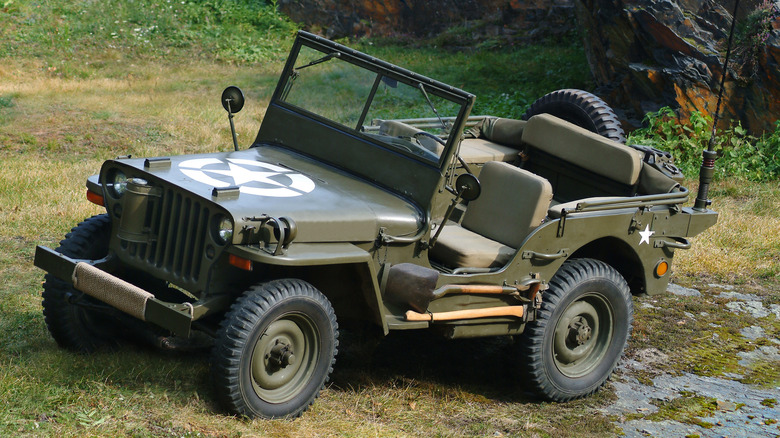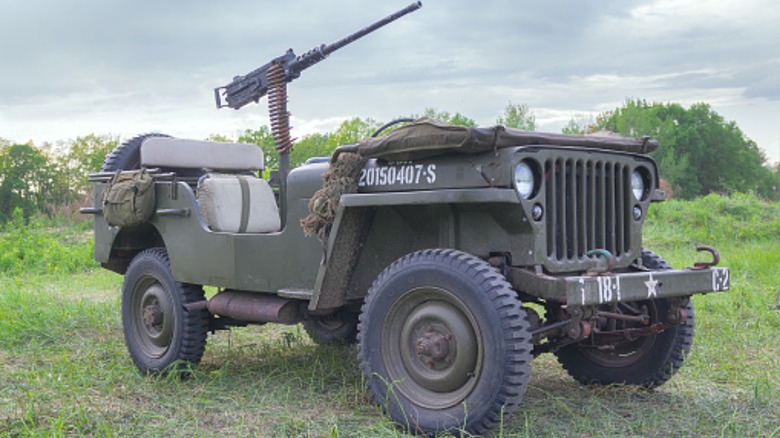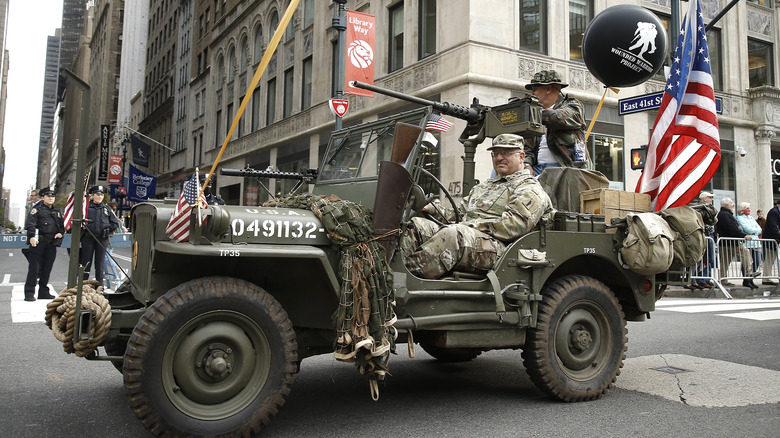Why The Jeep Was America's Greatest Contribution To Modern Warfare
You may not think it to look at it, but when it entered the Army inventory, the Jeep was a game-changer for modern military operations. Called many things, including GP, Jeep, and the G-503, among others, it entered military service in 1941. It didn't take long for Gen. George C. Marshall to call it "America's greatest contribution to modern warfare," which is telling, seeing as he was the U.S. Army Chief of Staff during World War II.
News reporter Ernie Pyle described the Jeep, saying, "It did everything. It went everywhere. Was as faithful as a dog, as strong as a mule, and as agile as a goat. It constantly carries twice what it was designed for and still kept going." That's high praise for any vehicle. It is for that reason, perhaps, that the Jeep brand endures even today, though its design has evolved considerably since its inception. Still, looking at a WWII Jeep might leave more than a few wondering why it was so special.
After all, the original wasn't up-armored. It was completely open, and, compared to the HMMWV or "Humvee," it's comparatively unimpressive. So how did a relatively simple four-wheeled vehicle land alongside the C-47, bazooka, and atomic bomb on President Dwight D. Eisenhower's list of four weapons that helped win the conflict? Primarily, the Jeep's versatility made it a workhorse for every branch of the military, and, by 1945, an astonishing 647,925 (made by three manufacturers) rolled off assembly lines.
The Jeep's versatility made it ideal for all situations
The jeep came with high expectations when the government approached American automakers about creating a vehicle for the war. This land rover had to carry three people, be four-wheel drive, have a fold-down windshield, could carry 660 lbs., have an engine capable of at least 85 ft.-lbs of torque, weigh no more than 1,300 lbs when empty, and have a wheelbase of 75". That was a tall order, and only three of the 135 companies the government approached gave it a shot.
Ultimately, while all three companies, Willys-Overland Motors, Ford Motor Company, and American Bantam Car Company, made a version of the Jeep, the Army eventually required standardization. By mid-1941, the familiar design known as the Willys MB emerged. In terms of versatility, there wasn't much this Jeep couldn't do. The military used the Jeep for transportation, but it could also house Browning .30 caliber and .50 caliber machine guns, function as an ambulance, cargo transport, anti-aircraft defense, radio car, trench mortar unit — really anything the Army needed.
The Jeep's use in so many functions explains the demand, and with more than 600,000 produced, it became one of the first mass-produced 4x4 vehicles in history. The Jeep continued operation well into the Korean War, though it got some upgrades and updates. By the 1960s, the original Jeep had been transformed into the M151 Jeep, while the initial concept inspired the civilian Jeep model CJ-2A, which entered the market in 1945.
The Jeep was a soldier's best friend
Besides a rifle and a few pairs of dry socks, the Jeep was a soldier's best friend during WWII. Jeeps operated successfully in every theater of war the U.S. deployed, and they had an excellent track record. Jeeps could run in any environment, were easy to repair and maintain, and were easily transportable by ships and aircraft, including gliders, ensuring they got to the front lines wherever and whenever troops needed.
Not only were the Americans and their allies happy to use the Jeep, but the Germans were as well. German troops greatly coveted allied Jeeps for capture, and when they got their hands on one, Germans repurposed Jeeps for day-to-day use. Historian Hugh Cole interviewed Wehrmacht generals following their surrender, and the consensus was that the Jeep was beloved.
Long after the conflict ended, the Jeep remained culturally significant. Outside the commercial Jeep company, enthusiasts continue buying, building, and restoring WWII-era Jeeps. A huge community is involved in this endeavor, which shows how deep Jeep appreciation runs. While it remains one of the most essential military technologies that helped win WWII, it's also an enduring example of how a military machine entered and remained a part of popular culture.


